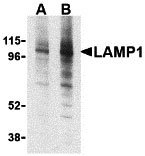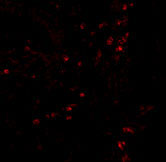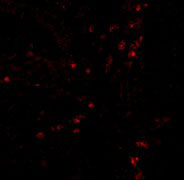LAMP-1 Antibody
- 产品详情
- 实验流程
- 背景知识
Application
| WB, IF, E, IHC-P |
|---|---|
| Primary Accession | P11279 |
| Other Accession | NP_005552, 112380628 |
| Reactivity | Human, Mouse, Rat |
| Host | Rabbit |
| Clonality | Polyclonal |
| Isotype | IgG |
| Calculated MW | 44882 Da |
| Concentration (mg/ml) | 1 mg/mL |
| Conjugate | Unconjugated |
| Application Notes | LAMP-1 antibody can be used for the detection of LAMP-1 by Western blot at 1 - 2 µg/mL. Antibody can also be used for immunohistochemistry starting at 20 µg/mL. For immunofluorescence start at 20 µg/mL. |
| Gene ID | 3916 |
|---|---|
| Other Names | LAMP-1 Antibody: LAMPA, CD107a, LGP120, Lysosome-associated membrane glycoprotein 1, CD107 antigen-like family member A, LAMP-1, lysosomal-associated membrane protein 1 |
| Target/Specificity | LAMP1; LAMP-1 antibody is predicted to not cross-react with LAMP-2. Due to extensive post-translational modification, LAMP-1 often migrates at higher than predicted molecular weight in SDS-PAGE. |
| Reconstitution & Storage | LAMP-1 antibody can be stored at 4℃ for three months and -20℃, stable for up to one year. As with all antibodies care should be taken to avoid repeated freeze thaw cycles. Antibodies should not be exposed to prolonged high temperatures. |
| Precautions | LAMP-1 Antibody is for research use only and not for use in diagnostic or therapeutic procedures. |
| Name | LAMP1 {ECO:0000303|PubMed:23632890, ECO:0000312|HGNC:HGNC:6499} |
|---|---|
| Function | Lysosomal membrane glycoprotein which plays an important role in lysosome biogenesis, lysosomal pH regulation, autophagy and cholesterol homeostasis (PubMed:37390818). Acts as an important regulator of lysosomal lumen pH regulation by acting as a direct inhibitor of the proton channel TMEM175, facilitating lysosomal acidification for optimal hydrolase activity (PubMed:37390818). Also plays an important role in NK-cells cytotoxicity (PubMed:2022921, PubMed:23632890). Mechanistically, participates in cytotoxic granule movement to the cell surface and perforin trafficking to the lytic granule (PubMed:23632890). In addition, protects NK-cells from degranulation-associated damage induced by their own cytotoxic granule content (PubMed:23847195). Presents carbohydrate ligands to selectins (PubMed:7685349). |
| Cellular Location | Lysosome membrane; Single-pass type I membrane protein. Endosome membrane; Single- pass type I membrane protein. Late endosome membrane; Single-pass type I membrane protein. Cell membrane; Single-pass type I membrane protein. Cytolytic granule membrane; Single-pass type I membrane protein. Note=This protein shuttles between lysosomes, endosomes, and the plasma membrane (By similarity). Colocalizes with OSBPL1A at the late endosome (PubMed:16176980). {ECO:0000250|UniProtKB:P05300, ECO:0000269|PubMed:16176980, ECO:0000269|PubMed:17897319} |
For Research Use Only. Not For Use In Diagnostic Procedures.
Provided below are standard protocols that you may find useful for product applications.
BACKGROUND
LAMP-1 Antibody: Autophagy, the process of bulk degradation of cellular proteins through an autophagosomic-lysosomal pathway is important for normal growth control and may be defective in tumor cells. It is involved in the preservation of cellular nutrients under starvation conditions as well as the normal turnover of cytosolic components and is negatively regulated by TOR (Target of rapamycin). A protein recently found to be involved in autophagy, LAMP-2, is a highly glycosylated protein associated with the lysosome. LAMP-1 shares much homology to LAMP-2 and is thought to have overlapping functions. Mice lacking LAMP-1 had very minor defects compared to those deficient in LAMP-2 expression. However, the loss of both proteins resulted in embryonic lethality, suggesting that each protein possesses some unique and necessary functions.
REFERENCES
Gozuacik D and Kimchi A. Autophagy as a cell death and tumor suppressor mechanism. Oncogene. 2004; 23:2891-906.
Kisen GO, Tessitore L, Costelli P, et al. Reduced autophagic activity in primary rat hepatocellular carcinoma and ascites hepatoma cells. Carcinogenesis1993; 14:2501-5.
Kamada Y, Funakoshi T, Shintani T, et al. Tor-mediated induction of autophagy via Apg1 protein kinase complex. J. Cell. Biol. 2000; 150:1507-13.
Chen JW, Murphy TL, Willingham MC, et al. Identification of two lysosomal membrane glycoproteins. J. Cell Biol. 1985; 101:85-95.
终于等到您。ABCEPTA(百远生物)抗体产品。
点击下方“我要评价 ”按钮提交您的反馈信息,您的反馈和评价是我们最宝贵的财富之一,
我们将在1-3个工作日内处理您的反馈信息。
如有疑问,联系:0512-88856768 tech-china@abcepta.com.























 癌症的基本特征包括细胞增殖、血管生成、迁移、凋亡逃避机制和细胞永生等。找到癌症发生过程中这些通路的关键标记物和对应的抗体用于检测至关重要。
癌症的基本特征包括细胞增殖、血管生成、迁移、凋亡逃避机制和细胞永生等。找到癌症发生过程中这些通路的关键标记物和对应的抗体用于检测至关重要。 为您推荐一个泛素化位点预测神器——泛素化分析工具,可以为您的蛋白的泛素化位点作出预测和评分。
为您推荐一个泛素化位点预测神器——泛素化分析工具,可以为您的蛋白的泛素化位点作出预测和评分。 细胞自噬受体图形绘图工具为你的蛋白的细胞受体结合位点作出预测和评分,识别结合到自噬通路中的蛋白是非常重要的,便于让我们理解自噬在正常生理、病理过程中的作用,如发育、细胞分化、神经退化性疾病、压力条件下、感染和癌症。
细胞自噬受体图形绘图工具为你的蛋白的细胞受体结合位点作出预测和评分,识别结合到自噬通路中的蛋白是非常重要的,便于让我们理解自噬在正常生理、病理过程中的作用,如发育、细胞分化、神经退化性疾病、压力条件下、感染和癌症。








